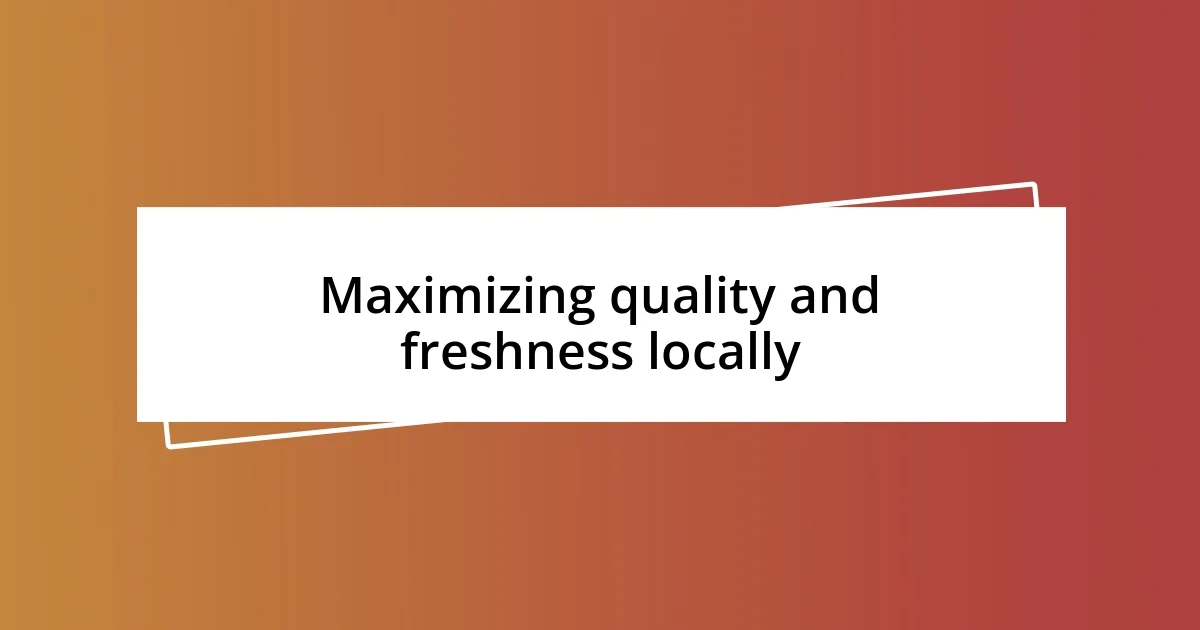Key takeaways:
- Local sourcing fosters community relationships, enhances product freshness, and reduces transportation costs, making food purchases more meaningful and sustainable.
- Building strong connections with local farmers leads to trust, transparency, and tailored produce that aligns with individual needs, enriching the overall food experience.
- Promoting local products through storytelling and social media engagement significantly increases customer satisfaction and community involvement, driving sales growth and repeat business.

Understanding local sourcing benefits
When I first dove into local sourcing, I was surprised by how much it strengthened my sense of community. It’s not just about reducing transportation costs; it’s about building relationships with local farmers and artisans. Have you ever visited a farmer’s market and struck up a conversation with a vendor? That connection makes purchasing feel more personal and meaningful.
One advantage I didn’t expect was the freshness of the products. When I switched to sourcing my ingredients locally, the difference in taste was remarkable. I recall trying a tomato that was picked the same day—it was bursting with flavor! Doesn’t that make you think about how often we settle for lackluster produce just because it’s convenient?
Additionally, local sourcing can significantly benefit the environment. By supporting nearby businesses, I felt like I was making small but impactful choices that helped reduce carbon footprints. The realization that my decisions could contribute to sustainability often leaves me reflecting—how many of us take the time to make choices that positively influence our world?

Identifying local suppliers effectively
Identifying local suppliers effectively requires a keen understanding of your community and market. I often start by exploring local directories and chambers of commerce, which can be treasure troves of information. In my experience, a simple phone call or visit can reveal suppliers who are eager to collaborate. Have you discovered a hidden gem in your town? Those are the connections that can lead to high-quality partnerships.
Networking also plays a significant role in uncovering local suppliers. I recall attending a community event where I met several local producers. Just by engaging in conversations, I learned about their offerings and commitment to quality. It was refreshing to see how passionate they were about their crafts; it made me want to support them even more. Isn’t it fascinating how relationships can shape our sourcing decisions?
Lastly, utilizing social media and online platforms can enhance your search for local suppliers. I’ve found that many artisans share their stories and products on Instagram, creating an engaging way to connect. That personal touch often leads to deeper conversations and potential collaborations. Have you ever reached out to a local vendor online? You might be surprised at how welcoming they are.
| Method | Advantages |
|---|---|
| Local Directories | Easy access to a variety of local businesses |
| Networking Events | Build relationships with passionate producers |
| Social Media | Engaging insights from suppliers |

Building relationships with local farmers
Building strong relationships with local farmers can transform the way we think about food sourcing. I remember the first time I visited a farm just outside my town; the farmer welcomed me with open arms, eager to share stories about their cultivation practices. It was in that moment I realized that each product comes from a person who pours their heart into their work. It’s about the passion behind the produce, not just the produce itself.
As I cultivated these relationships, I noticed several benefits that cropped up:
-
Trust and Transparency: Knowing the people who grow my food makes me feel more secure about the quality and safety of what I’m consuming.
-
Tailored Produce: By discussing my needs with local farmers, I often find unique varieties and fresh produce that align perfectly with what I want to create in the kitchen.
-
Community Engagement: Building these bonds turns me into an advocate for their farms, often creating a ripple effect where friends and family become aware of the local offerings.
In reflecting on my experiences, I can’t help but feel that each relationship I’ve nurtured has added a layer of meaning to my meals. The excitement of not just sharing food, but also the stories behind them, makes every dining experience more enriching.

Maximizing quality and freshness locally
Maximizing quality and freshness when sourcing locally is all about fostering connections that go beyond a simple transaction. I’ll never forget my first visit to a local cheese maker. As I watched the cheese being crafted, I felt a genuine sense of pride in supporting someone who dedicated their life to this artisanal process. The freshness in that product was palpable; it’s an experience that simply can’t be replicated by purchasing mass-produced goods. Have you ever tasted something so fresh that it changed your perspective?
Finding fresh produce is simpler than it seems when you tap into the abundance around you. I often participate in local farmers’ markets, where the vibrant colors and scents promise quality. It’s exhilarating to chat with the vendors about their harvests—it adds a layer of authenticity to my choices. I once met a baker at one such market who shared her passion for using locally sourced ingredients. The bread I bought was not just food; it was a story of community and collaboration. Isn’t it amazing how a simple loaf can carry the essence of a neighborhood?
Seasonal sourcing also plays a crucial role in maximizing quality. I’ve started paying close attention to what’s in season, and I can honestly say my meals have become more exciting. For instance, last summer I embraced the abundance of heirloom tomatoes, throwing together vibrant salads that were bursting with flavor. Each bite was a celebration of the local harvest. How often do we overlook the magic that seasonal ingredients can bring to our dishes? By embracing what’s fresh, I’ve learned that every meal becomes an opportunity to showcase the best our local producers have to offer.

Reducing costs with local sourcing
When I first shifted to local sourcing, the impact on my budget was significant. I recall eyeing a basket of freshly picked strawberries at the farmers’ market—$5 for a quart—and thinking, “This is so much better than the $3.50 for a half-pint from the grocery store, which were shipped from who-knows-where.” It struck me that the reduced transportation costs often translate to better prices for consumers, while also supporting my community. Isn’t it fantastic when saving money aligns with supporting local agriculture?
Another advantage I’ve noticed is the reduced reliance on intermediaries in the supply chain. When I buy directly from farmers, they’re able to offer competitive prices because they cut out the middleman. One weekend, I visited a local vegetable stand and struck up a conversation with the owner about their harvest. They explained how directly sourcing from them enables me to get fresher produce at lower prices. It felt gratifying to be part of this straightforward exchange. When you think about it, why wouldn’t you want to support a system that benefits both your wallet and your local economy?
I also realized that local sourcing led to minimal packaging, which can be a financial relief. Many local sellers offer produce with little to no packaging. I remember switching to bulk purchases from a nearby co-op where I filled my jars with grains—no plastic wrap needed. The savings accumulated, and it felt good knowing I’m not just saving money, but also reducing waste. Have you ever thought about how those little changes might affect your budget in ways you hadn’t expected? Embracing local sourcing has led me to more sustainable choices—both financially and environmentally.

Strategies for promoting local products
To effectively promote local products, storytelling is a powerful tool. I remember attending a local art fair where each artist shared the inspiration behind their works. One painter vividly described how the landscape of our town influenced her choice of colors. This connection between the product and the producer made me more inclined to purchase. Have you ever realized how a simple narrative can transform your perception of a product?
Another approach I find impactful is leveraging social media platforms to highlight local businesses. I often share photos of my favorite local food spots on Instagram, showing friends the vibrant dishes crafted from regional ingredients. This not only promotes these establishments but also builds a sense of community. Isn’t it rewarding to know that a quick post can encourage others to explore what’s nearby?
Engaging in collaborative events can also make a significant difference. I once participated in a farm-to-table dinner where local chefs showcased dishes made from nearby farms. The camaraderie in that space was palpable, and it introduced me to new flavors while championing the local economy. It made me think—what if more communities organized these events to support local flavors and stories?

Measuring success in local sourcing
When it comes to measuring success in local sourcing, one of the most tangible metrics I look at is customer satisfaction. After attending a local farm’s open house, I felt so connected to the growers that I immediately began sharing my experience with friends. The cheerful demeanor of the farmers and the pride they took in their produce were infectious. Do customers feel the same joy when they buy your products? Tracking feedback through surveys or informal conversations can really gauge how this local connection enhances their buying experience.
I also consider the impact on community engagement as a critical measure. When I attended a local market, I was struck by how many people knew each other, exchanging recipes and tips on how to prepare the ingredients they just purchased. The sense of belonging was immense. Monitoring how often customers return and their level of interaction can provide valuable insights into how effectively local sourcing fosters community relationships. Have you ever noticed how these bonds can influence repeat business?
Lastly, analyzing sales growth attributed to local sourcing gives a clear picture of its success. I remember a season where my purchases from a local bread maker skyrocketed after I posted some photos of their artisan loaves on social media. The interaction was effortless, but it translated directly into more sales for them, highlighting the power of local support. Are you tracking your sales data to see how local partnerships impact your bottom line? These metrics help in understanding how effective your local sourcing strategy really is.












